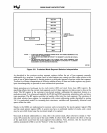
80286
BASE
ARCHITECTURE
Beyond their code and stack requirements, most programs must also fetch and store data
in
memory.
The
DS and ES registers
allow
the specification of
two
data segments, each addressable
by
the currently
executing program. Accessibility to
two
separate data areas supports differentiation and access require-
ments like local procedure data and global process data.
An
operand within a data segment
is
addressed
by specifying its offset either directly in an instruction or indirectly via index and/or base registers
(described
in
the next subsection).
Depending
on
the data structure (e.g., the
way
data
is
parceled into
one
or more segments), a program
may require access to multiple data segments. To access additional segments, the
DS and ES registers
can be loaded under program control during the course of a program's execution. This simply requires
loading the appropriate data pointer prior to accessing the data.
The interpretation of segment selector values depends
on
the operating mode of the processor. In Real
Address Mode, a segment selector
is
a physical address (figure 2-5). In Protected Mode, a segment
selector selects a segment of the user's virtual address space (figure
2-6).
An
intervening
level
of logical-
to-physical address translation converts the logical address
to
a physical memory address. Chapter 6,
"Memory Management," provides a detailed discussion of Protected Mode addressing. In general,
considerations of selector formats and the details of memory mapping need not concern the application
programmer.
2.3.3
Index, Pointer,
and
Base Registers
Five of the general-purpose registers are available for offset address calculations. These
five
registers,
shown
in
figure
2-4,
are SP, BP, BX, SI, and
DL
SP
is
called a pointer register; BP and
BX
are called
base registers;
SI
and DI are called index registers.
SEGMENT
64K
{
BYTES
I
BASE ADDRESS
SEG
1
1 MEGABYTE PHYSICAL
ADDRESS SPACE
I SELECTOR I
0000
I
NOTES: 1. THE SELECTOR IDENTIFIES A SEGMENT
IN
PHYSICAL MEMORY.
2. A SELECTOR SPECIFIES THE SEGMENTS BASE ADDRESS, MODULO 16, WITHIN
THE 1 MEGABYTE ADDRESS SPACE.
3. THE SELECTOR IS THE
16
MOST SIGNIFICANT BITS
OF
A SEGMENTS PHYSICAL
BASE ADDRESS.
4. THE VALUES
OF
SELECTORS DETERMINES THE AMOUNT THEY OVERLAP
IN
REAL
MEMORY.
5. SEGMENTS MAY OVERLAP BY INCREMENTS
OF
16
BYTES. OVERLAP RANGES FROM
COMPLETE (SEG 1
~
SEG
1) TO NONE (SEG 1 *
SEG
2 ±
64K)
Figure 2-5. Real Address Mode Segment Selector Interpretation
2-9
G3010a


















